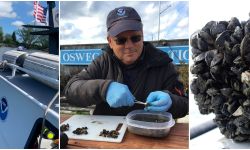Small portions: Michigan puts PFAS advisory on Lake Superior rainbow smelt

Citing new data showing PFAS contamination in Lake Superior rainbow smelt is more widespread than previously known, state regulators are again warning anglers and diners to limit their meals of the popular sportfish.
People eating smelt from the northernmost Great Lake should eat no more than one serving per month, the Michigan Department of Health and Human Services announced Monday. A serving is eight ounces (about two to three of the sardine-sized fish) for adults and two or four ounces for children.
The advisory comes just in time for the spring smelt run, a popular time for anglers to net the fish as they swim into Great Lakes tributaries to spawn.
Related:
- The pandemic that closed the U.S./Canadian border to people may have opened it to the invasive sea lamprey
- Michigan warns of PFAS contamination in Lake Superior smelt
- DNR announces fishing regulations for Michigan’s 2022 season
Lynn Sutfin, a spokesperson for MDHHS, said the agency recommends that diners who know the origins of their store or restaurant-bought fish limit their intake if those fish come from Lake Superior.
The announcement comes a year after Wisconsin officials found elevated levels of a PFOS — a PFAS compound that was once a key component in Scotchgard and other stain and water repellents — in smelt collected near the Apostle Islands in western Lake Superior.
Research has linked PFOS to developmental problems, hormonal and immunity problems, fertility issues, cancer and other human illnesses.
Following the Wisconsin find, Michigan officials warned against eating too much Lake Superior smelt, and followed up with their own smelt sampling at sites scattered across the lake’s southern shoreline. Elevated PFOS levels appeared in multiple samples, with the highest being 112 parts-per-billion in fish taken from Fourteen Mile Point, just northeast of Ontonagon.
For context, Michigan officials start advising people to limit consumption of fish when PFOS concentrations reach 9 parts-per-billion.
Brandon Reid, an MDHHS toxicologist who leads the agency’s “Eat Safe Fish” program, noted that the advisory is still “precautionary” because the state’s data has not been fully analyzed. Formal guidelines for Michigan could come next year, he said.
State officials also sampled smelt taken from Lake Huron and inland lakes including Gull and Higgins. They are awaiting final results, but Reid said preliminary data also suggests fish in those waterways are contaminated with PFAS, though “not quite as high as what we’ve been seeing in Lake Superior.”
For Roger LaBine, an enrolled member and environmental staffer for the Lac Vieux Desert Band of Lake Superior Chippewa Indians, the continued smelt advisory means he’ll have to cut back on the fish fries he typically relishes all spring before freezing bags full of smelt to eat throughout the year.
It’s nothing new for LaBine, who is already in the habit of rationing his walleye meals due to mercury contamination. Each new consumption advisory means further loss of access to the staple foods that have long sustained Great Lakes tribes.
“That’s just an additional contaminant that is infecting the great waters of the Great Lakes,” he said.“Everything that we actually hunt or fish or gather has been affected. So you have to find alternatives.”
The advisory comes as hunting and fishing advocacy groups like the Michigan United Conservation Clubs (MUCC) push for more resources to study the impacts of PFAS on Michigan’s fish and game.
MUCC spokesperson Nick Green expressed dismay at yet another limit on Michiganders’ ability to participate in the $11.2 billion hunting and fishing industry.
“When you start to chip away at fish and game, that money starts to disappear as well,” Green said.
State officials have not identified a source of the Lake Superior PFAS pollution, said Scott Dean, a spokesperson for the Michigan Department of Environment, Great Lakes and Energy.
Dean said EGLE also collected lake herring samples from lakes Superior and Michigan, but test results are not yet available.
The state’s latest data on PFAS in Michigan’s fish contains a glimmer of good news: Data from southeast Michigan’s Huron River, another heavily-contaminated waterway, suggests that fish contamination can subside once the poison chemicals stop flowing.
Fish in the 900-square-mile watershed are so contaminated with PFAS, state officials advise anglers to avoid eating any amount of fish from an area that spans five counties.
But contamination levels appear to have subsided since Tribar Manufacturing, a Wixom auto supplier responsible for much of the contamination, installed filters to clean its effluent.
Fish in the upstream areas closer to the factory still contain heavy PFAS contamination. But state officials have noticed “really promising” decreases in the lower river, from Flat Rock down to the river’s confluence with Lake Erie, said Reid.
MDHHS is preparing to adjust its consumption advisory in that section of the river in the coming months, enacting species-specific advisories instead of the blanket “do not eat” warning that currently applies to all fish.
Michigan Environment Watch
Michigan Environment Watch examines how public policy, industry, and other factors interact with the state’s trove of natural resources.
- See full coverage
- Subscribe
- Share tips and questions with Bridge environment reporter Kelly House
Michigan Environment Watch is made possible by generous financial support from:
Our generous Environment Watch underwriters encourage Bridge Michigan readers to also support civic journalism by becoming Bridge members. Please consider joining today.
See what new members are saying about why they donated to Bridge Michigan:
- “In order for this information to be accurate and unbiased it must be underwritten by its readers, not by special interests.” - Larry S.
- “Not many other media sources report on the topics Bridge does.” - Susan B.
- “Your journalism is outstanding and rare these days.” - Mark S.
If you want to ensure the future of nonpartisan, nonprofit Michigan journalism, please become a member today. You, too, will be asked why you donated and maybe we'll feature your quote next time!






